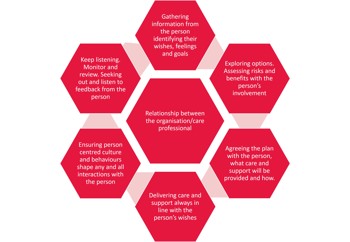
Person-centred care, meaning
The definition of person-centred care is that users of health and social services are seen as equal partners in planning, developing and monitoring care, in order to better meet their needs. Working in a person-centred way means considering people’s values, social connections, and lifestyles.
So what does person-centred care mean in practice?
The meaning of person-centred care lies in being compassionate, taking into account the person’s point of view, and working together to develop personalised solutions. This goes beyond just sharing decisions with individuals about their care, but also aims to transform the very nature of the relationships between individuals and their carers.
Paradoxically, by focusing on the individual’s needs rather than the needs of the service, it not only drives better outcomes for service users, but also reduces the service’s running costs.
Person-centred values
Person-centred values in care are the guiding principles that shape the way a service is delivered. By adhering to person-centred care values, staff are empowered to bypass rigid processes and systems to provide care which is specific to individual needs.
How many values are there that support person-centred care?
We can define person-centred values as follows:
- Individuality: Each person has their own identity, beliefs, values, needs, and choices. ‘One size fits all’ is an approach which does not work when it comes to providing care.
- Choice: Each person should be empowered to make choices about their care and support. They should be given information that they understand to ensure their choices are informed. For persons unable to communicate with words, alternative means of communication must be provided so that their voices are not neglected.
- Independence: Each person should be helped to be as independent as possible. This means helping them to do as much they can for themselves. It does not mean leaving people to cope alone, but rather to ensure that they have the support whenever and wherever they need it.
- Dignity: Each person should be treated with dignity, in a way that takes their ethical and moral beliefs into consideration. This means not making assumptions about how they may want to be treated and being conscious about how personal care may impact their dignity.
- Respect: Each person should be treated in a way that conveys their value as an individual. Therefore they are entitled to have their own opinions and feelings acknowledged, even if others may not agree with them.
- Rights: Each person should be assured the fundamental rights set out in The Human Rights Act 1998. This includes the right to life and be to kept safe from harm, as well as the right to liberty, security and equality.
- Privacy: Each person is entitled to private space and time whenever they need it. Privacy is vital in care, especially where personal hygiene or intimate procedures are involved. Access to personal information should only be granted on a need-to-know basis and only with the person’s consent.
- Partnership: Each person and their family should be treated as partners in making decisions about the care they receive. Successful partnership is built on good communication and trust, which means listening to others and valuing their perspectives.
The person-centred approach
Person-centred approaches focus on working in partnership with the individual to plan their care. Person-centred planning is a means to define the person-centred approach for staff and service users. Proper planning ensures staff are aware what is most important to the individual so they act accordingly.
Person-centred care planning has the following features:
- The individual is empowered to identify their strengths and abilities to make their own decisions about what’s best for them. For example, wanting to use a walking frame around their home instead of their wheelchair.
- The care plan is owned by the individual and is written in the first person. For example: “I would like to use a walking frame around my home instead of my wheelchair.”
- The individual has full support over the choices they make. For example, the individual is given support to learn to use a walking frame.
- The care plan is ‘needs led’ and not ‘service led.’ This means that support is designed to fit individuals’ needs, and individuals are not asked to fit their needs around a pre-existing service. For example, if the service does not have a walking frame that meets the individual’s requirements, they will source one from elsewhere.
Examples of person-centred care
Person-centred care examples are used to illustrate how individuals are empowered to make informed choices about the risks that are involved in their treatment and care. This helps them to contribute to their own safeguarding and minimise the risk of negative, unfair or harmful treatment.
The following examples illustrate an approach to treatment and care which avoids paternalism. Paternalism inevitably creates dependency and feelings of helplessness. The focus instead is on a more holistic and compassionate approach to treatment and care that starts from the perspective of the individual rather than the caregiver.
Here are some person-centred approach examples:
- Making sure people are physically comfortable and safe.
- Considering people’s preferences and chosen needs.
- Placing people’s values at the centre of care.
- Providing emotional support, involving friends and family.
- Making sure people have access to the care that they need, where and when they need it.
- Ensuring information is accessible to allow people to make informed decisions about their care and support.
- Adjusting the time people go to bed to when it best suits them.
- Providing tools for people to perform everyday tasks unaided, from seats in the shower to devices to help with putting on shoes.
- Giving people a choice of what to have for dinner.
- Not making decisions for people, but rather making decisions with them.

Principles of person-centred care
The Health Foundation has formulated four principles of person-centred care to serve as a guide to care providers. The principles of person-centred care are flexible as much depends on the needs, circumstances and preferences of the individual receiving care.
Individuals’ change over time and what is important to one person may be unnecessary, or even undesirable to another.
So what are the 4 principles of person-centred care?
1. Treat people with dignity, compassion, and respect
People can often lose their independence when they go into care. Never forget that everyone who uses care services has their own thoughts, feelings, opinions and needs. Respecting individual choice empowers the person to feel more in control physically and mentally. This in turn leads to the person exercising more independence, creating better outcomes.
2. Provide coordinated care, support, and treatment
All care should be aligned, and all support services and care workers must be coordinated. If not, care services become disjointed, and the understanding of people’s personal wants and needs must be rebuilt from scratch.
All carers should communicate clearly to each other, maintaining accurate and legible care plans and medication records. This facilitates a shared understanding across all services while maintaining confidentiality where required.
Digitising care plans and MARs is the best way to ensure records are well maintained, legible, and accessible to the entire care team. Having a common electronic record means updates are shared, so people are not using different or outdated versions.
When automated workflows are built into the software, requests to change a person’s care to meet their wants and needs can be escalated and acted on without requiring staff approval. This ensures opportunities to increase personalisation are not missed.
3. Offer personalised care, support, and treatment
This principle calls for understanding, as what works for one person may not work for another. Personalising services for each client allows them to retain some of their freedom to fulfil their wants and needs. An overly standardised approach may hinder people’s ability to manage their condition correctly.
4. Enable people to recognise and develop their strengths and abilities for an independent and fulfilling life
People should be involved in decision making, so care providers must empower them to take actions to support themselves. This is useful for both care services and clients, as clients will become more in control and less dependent on their services. Insufficient engagement could make service users feel they have no say in decisions made about them, so maintaining an open communication strategy is essential.
Person-centred practice
Person-centred practice aims to make person-centred care a reality by embedding it into working practices. Person-centred practice should cover every aspect of the service: initial assessments, writing care and support plans, the complaints process, and the overall relationship between staff and service users.
Person-centred practice is not a one-off event. It is not just asking a person their needs, likes and preferences at the start of their care delivery. Rather it is a cyclical process of active listening, regular adjusting, and continuous improving.
The following diagram illustrates this cyclical process with some person-centred practice examples:

Diagram recreated, with additions, from Social Care Institute for Excellence.
As a person is receiving care, staff should be listening and gathering more information about the person. The information is used to feed back into the cycle to explore new options and evolve care plans. This in turn makes the care even more person-centred.

What is person-centred care in health and social care?
The person-centred approach in health and social care is increasingly recognised as good practice. Many health and social care workers use person-centred approaches to engage with people in a more meaningful way. Health coaching, motivational interviewing, and co-production are different applications of person-centred practice.
Person-centred care in the UK is governed by various regulatory bodies, depending on the country where the service is located:
England
In England, the Care Quality Commission (CQC) codifies the principle of person care in Regulation 9 of the Health and Social Care Act 2008 (Regulated Activities) Regulations 2014:
“Providers must make sure that they take into account people's capacity and ability to consent, and that either they, or a person lawfully acting on their behalf, must be involved in the planning, management and review of their care and treatment.”
Though CQC cannot prosecute for a breach of this regulation or any of its parts, they can take regulatory action which typically impacts a provider’s overall CQC rating.
Scotland
The Care Inspectorate Scotland outlined in a recent whitepaper on COVID-19 and person-centred care the importance of remaining person-centred even when unexpected situations happen, such as the COVID-19 pandemic:
“Finding new ways to provide person-centred care, despite the immense challenges of this virus, has been essential for health and social care staff. They want to feel they are delivering the kind of care they would wish to give, and in enabling people receiving that care, to feel more wholly cared for as human beings.”
Wales
The Care Inspectorate Wales wrote a joint statement with Healthcare Inspectorate Wales in 2020 around ‘personalised advance care planning in Wales’ which aligned with the principles of person-centred care:
“As the inspectorates of health and social care in Wales, we have always taken an active role in inspecting and promoting personalised, compassionate and effective care. This role will continue in these challenging times. During this pandemic, it is critical that all staff involved in advance care planning follow the latest best practice guidance and access support available to them to have these discussions.”
Why is person-centred care important?
The importance or person-centred care is that it empowers clients to meet their emotional, social and practical needs. This enhances their quality of life while making them feel more confident in the service they’re receiving. The trust built enhances the relationship between the caregiver and the client.
Person-centred care has other significant benefits:
- Better value for money: Better informed clients chose more appropriate treatments. Often this means treatments that are less invasive and less expensive.
- Better adherence to treatment: People who participate in shared decision-making are more likely to stick to treatment plans.
- Less reliance on hospital services: People who are supported to manage their own care are less likely to need external services.
Person-centred care solutions
Person-centred care offers a more positive approach to care, ensuring the delivery of effective, compassionate care while improving care team morale. It also ensures a more efficient use of resources, giving time and cost savings.
At Access we have been offering solutions to the care industry for over 30 years. We currently work with over 6,000 care homes and over 4,500 community care agencies.
Our care management software offers a portfolio of integrated solutions to empower care providers to deliver person-centred care that is efficient, high-quality and safe.
The benefits of our software include:
- Increased efficiency
- Higher quality of service
- Better safety standards
- Data analytics
- Enhanced data security
- Secure information sharing
To find out more about the care management software we offer at Access, contact us here to discuss your needs or book a demo.
Ensure your care plans support person-centred care and impress the CQC with our free guide to person-centred care plans and the CQC.

 AU & NZ
AU & NZ
 SG
SG
 MY
MY
 US
US
 IE
IE

